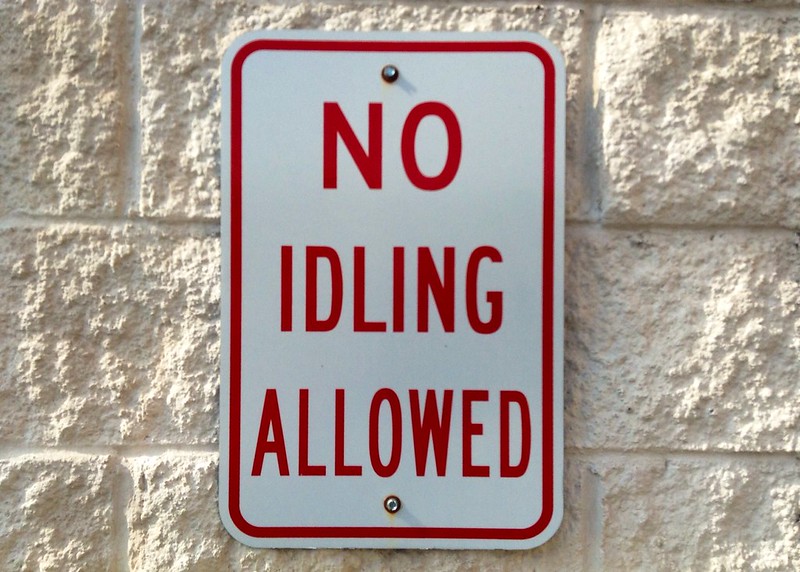
School busses across the United States consume a huge amount of fuel every day to get kids to and from school. It’s no wonder that transportation makes up one of the largest parts of most district’s yearly budget. Improving fuel efficiency through improving driver behavior, vehicle modifications and intelligent school bus management software is one great way to save money on transportation.
Improve driver behavior
There are certain things every driver can do to improve their vehicle’s fuel efficiency. Proper driver training in fuel efficient practices can save money without any additional spend on school bus routing solutions or vehicle modifications.

Image Credit: Mike Mozart / flickr
Avoid idling
For every hour a bus sits idle, fuel economy goes down by about 1 percent. While some idling is unavoidable, drivers should abide by the general rule that, if the vehicle is stationary for one minute or longer, the engine should be switched off.
Beyond proper driver training, the use of smart school bus routing and innovative idling technology can reduce the amount of time busses are waiting to get moving. Bus routing software can help to plan a more efficient route for school transportation so that each unit is avoiding congested routes where possible, keeping them moving efficiently along their route and minimizing the amount of time they are standing still wasting fuel. If school bus GPS routing isn’t enough, school busses can be fitted with vehicle idle shutdown timers to automatically shut off the engine after a certain period of inactivity.
Accelerate efficiently
How and when a bus driver speeds up and slows down can have an impact on bus fuel efficiency. Slow, smooth acceleration ensures that the vehicle’s engine stays in peak performance. Gears should be changed as much as possible as the bus picks up speed, as higher gears have better fuel efficiency. Training drivers in fuel-efficient driving behaviors is a great way to make the most of your fleet without any modifications.
It might be counterintuitive but driving slower may actually save you on fuel. According to the Department of Energy, reducing vehicle speed by 5 to 10 mph can improve a vehicle’s fuel economy by up to 14%. This small decrease will not make a huge impact on travel time but could make a difference at the pump.
Be brake smart
Much like acceleration, braking is a simple driving behavior that can make a significant impact on Frequent and sudden breaking brings the bus to an abrupt stop, forcing the driver to work back up through lower gears, reducing fuel economy. Bus drivers should, where possible, use engine breaking to slow down. By shifting down gears, rather than the pedal brake, the bus can be brought to a gentler stop, avoiding the need for sudden acceleration. Depending on the situation, the bus may not need to stop at all. School bus management software can help drivers to anticipate traffic further down the route, allowing them the chance to slow down in advance or even reroute, saving time and fuel.
Maintain your fleet
Intelligent school bus routing and efficient driver behaviors are important but can only get you so far. Good vehicle condition, and how well it is maintained, is still a significant factor in increasing fuel efficiency.
Check the tires
High-quality, well-maintained tires are essential on any vehicle, especially a school bus. School busses put a lot of pressure on their tires, partly due to the regular use, but also because of the frequent stopping and starting at pick-ups and drop offs. Drivers and school transport managers should check regularly that tires are inflated properly – not too much, not too little. Treads should be deeper than on car or van tires to have a longer lifespan. Any damage or wear and tear should be identified and fixed straight away, or tires should be replaced.
Check axle alignment and lubrication
Older school busses that have seen years of hard service may have misaligned axles that are reducing their fuel economy. Axles can be put out of alignment by a sudden shock, for example by hitting a speed bump or pothole at the wrong angle, or by regular wear and tear. A misaligned axle increases the vehicles drag and puts more pressure on tires, causing them to wear out quicker. Altogether, a poorly aligned bus axle can reduce fuel economy by around 0.6%. Any experienced mechanic will be able to identify whether a school bus axle has fallen out of alignment.
Reduce axle wear and increase fuel efficiency at the same time by using the right axle lubricants. Synthetic lubricants flow better than mineral oils at ambient temperatures, making them last longer and increase movement efficiency. Just take care not to overuse lubricants, as that can reduce efficiency and counteract this positive effect.
Pick the right parts
Not all bus parts are created equal. If you are really determined to increase bus fuel efficiency, modifying, or replacing the engine and related components can significantly increase fuel efficiency. In 2008 the EPA altered their engine testing procedure, meaning that engines produced in 2007 or before are generally less fuel efficient. In auto-transmission busses, using the fuel economy mode can increase fuel efficiency by around 5%.
Some bus managers even replace engines entirely to improve fuel efficiency. Diesel engines are significantly more efficient, getting around 25 to 30% more miles to the gallon compared to gas engines. However, the money saved on fuel can often be spent elsewhere, as diesel engines can be harder and more costly to fix and maintain. You might even consider abandoning liquid fuels entirely in favor of electric or hybrid electric busses. Fuel efficiency on these greener alternatives can be 60% higher or more compared to gas and diesel engines, making them a great choice for smaller districts.
Explore school transportation software and hardware
Modern transportation technology is better than ever at improving vehicle performance, increasing route efficiency, and improving student safety. While training drivers and maintaining a fleet are essential steps for any school transportation manager, taking advantage of school bus management software can help take vehicle and route efficiency to the next level. School transportation software can help with school bus routing, generate reports on driver behaviors, and track and analyze a wide range of valuable data to ensure you have the most information you need to save money on fuel.



